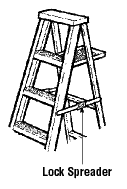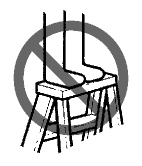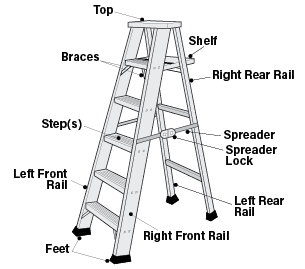Ladders - Step
On this page
What should you do when using a stepladder?
Back to top- Conduct a risk assessment when working at heights. It may be necessary to use fall protection equipment while working on a ladder.
- Check the load rating that is marked on the stepladder. The rating should cover the person's weight and the weight of tools that will be used.
- Use a stepladder that is about 1 m (3 ft) shorter than the highest point you have to reach. This length of ladder gives a wider, more stable base and places shelf at a convenient working height.
- Check the ladder for racks, lose or corroded rivets, defective braces, or parts (including the slip resistant feet) that are in poor condition. Make sure it is free of grease or oil or other slippery substances.
- Open the stepladder spreaders and shelf fully and lock the braces.
- Check stability. Make sure that all ladder feet are on a firm, level, and non-slippery surface.
- Place a stepladder at right angles to the work, with either the front or back of the steps facing the work.
- Keep the stepladder close to the work.

- Lift and carry the ladder when moving it. Do not push or pull stepladders from the side. Repeated sideways movement can make ladders unstable since they are weaker in those directions.
- Face the stepladder when climbing up or down.
- Keep your body centered between side rails. The ladder can become unstable if your body or equipment you are holding move beyond the side rails.
- Work at an appropriate height for the ladder. Generally speaking, you have climbed too high if your knees are above top cap of the stepladder or if you cannot maintain a handhold on the ladder.
- Maintain a firm grip. Use both hands when climbing.
- Keep both feet on the ladder. Do not stand on a ladder and other object at the same time (for example, 1 foot on the ladder and 1 foot on anther object).
What are step ladder ratings, and is there a maximum length for a step ladder?
Back to topThe Canadian Standards Association (CSA) Standard Z11-18 recommends different lengths for different rating (or grades) of step ladders.
| Grade | Description of Grade | Maximum Length |
|---|---|---|
| 1AA | Construction and industrial use; special duty with load rating of 170 kg (375 lbs) | 6 m (20 ft) |
| 1A | Construction and industrial use; extra heavy duty with load rating of 136 kg (300 lbs) | 6 m (20 ft) |
| 1 | Construction and industrial use; heavy duty with load rating of 113 kg (250 lbs) | 6 m (20 ft) |
| 2 | Tradesmen and farm; medium duty with a load rating of 102 kg (225 lbs) | 3.6 m (12 ft) |
| 3 | Household; light duty with load rating of 91 kg (200 lbs) | 2 m (6.5 ft) |
How high should a person stand on a step ladder?
Back to topThe Canadian Standards Association (CSA) Standard Z11-18 recommends different standing levels, depending on the size of the step ladder. Note that these are the highest levels recommended. Persons should stand lower on the ladder if they feel unstable.
Step ladder size |
Recommended highest standing level |
1.22 m (4ft) |
0.58 m (2 ft) |
1.52 m (5 ft) |
0.89 m (3 ft) |
1.83 (6 ft) |
1.17 m (4 ft) |
2.13 (7 ft) |
1.47 m (5 ft) |
2.44 m (8 ft) |
1.78 m (6 ft) |
3.05 m (10 ft) |
2.36 m (8 ft) |
3.66 m (12 ft) |
2.95 m (10 feet) |
What should you avoid when using a stepladder?
Back to top- Do not overreach. Move a stepladder when needed.
- Do not "shift" or "walk" a stepladder when standing on it.
- Do not stand, climb, or sit on the stepladder top or pail shelf.
- Do not overload. Stepladders are meant for one person.
- Do not use a stepladder as a brace or as a support for a work platform or plank.

- Do not climb a stepladder that is leaning against a wall. Use a straight ladder instead.
- Do not use stepladders on slippery surfaces
- Do not use stepladders on soft ground where one leg may sink farther into the ground than others.
- Do not place stepladders on boxes, barrels, unstable bases, or on scaffolds to gain additional height.
- Do not climb the back of a stepladder.
- Do not push or pull stepladders sideways.
- Do not use ladders in passageways, doorways, driveways or other locations where a person or vehicle can hit it. Set up suitable barriers or lock doors shut.
- Do not carry tools or equipment while climbing.

- Fact sheet last revised: 2022-06-27
